|
Elmer Perrin was the first child born April 7, 1896 into what was to become a large farm family at Boerne, TX near San Antonio. He graduated from the Main Avenue High School, San Antonio and attended Texas A&M at College Station, TX. I am not sure if he earned a degree, or what the degree was. He enlisted in the Army October 27, 1917 during WWI and was commissioned a second lieutenant on July 5, 1918. I have no information about his duties during or immediately after WWI.
According to the Military Register for 1921, Air Service, he was honorably discharged on October 31, 1919 with the rank of second lieutenant. The U.S. Census for 1920 (tabulated in January when he was 23 years old) places him at home in Texas with his mother Willie Fannie (age 46), father John (52), a farmer, and seven siblings (four sisters and three brothers). They owned their home free and clear. Perrin was identified as single and a farm laborer. He was reinlisted on July 1, 1920 with the rank of first lieutenant. At age 26, about 1922, he married Bessie June King.
He took pilot training at Kelly Field, Texas, in 1920. He held the usual assignments in the Air Corps during the next 20 years, and by March, 1941 was promoted to lieutenant colonel, with assignment as Air Corps representative to the Glenn L. Martin aircraft company in Baltimore, MD (see below).
An unusual juxtaposition for an army aviator is the photograph, below, courtesy of site visitor Brad Purinton, that shows Perrin posed beside a navy airplane. The craft is a Macchi M.16, A-6006, three of which were purchased for testing by the navy. Mr. Purinton states, "Given that the M.16 was built in 1919, I'd guess the photo was taken in the early twenties." It is not clear if he flew this airplane; it does not appear in his flight logs described below.
E.D. Perrin With Macchi M-16, Ca. Early 1920s (Source: Purinton)
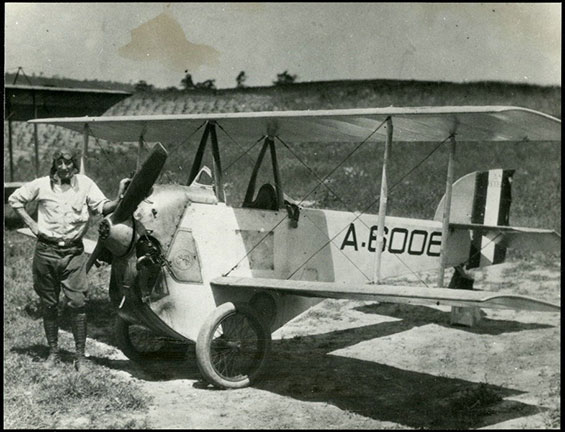 |
Below is the caption on the back of the photo. I "pushed" this image in PhotoShop so the penciled caption is easier to read. Neither Mr. Purinton or I have any idea why Perrin and the M.16 were in Syracuse, NY. An image of A-6005 on floats is at the link for the San Diego Aerospace Museum Flickr stream. Note at the top of that photograph the double exposure of soldiers in rank!
E.D. Perrin With Macchi M-16, Caption, Ca. Early 1920s (Source: Purinton)
 |
Perrin landed at Tucson five times between December 20, 1925 and August 29, 1933. Each time he identified his home base as San Antonio, TX. Some of the information on this page came from ancestry.com. Photograph, below, right, from Find-a-Grave.
Elmer D. Perrin, Date Unknown (Source: findagrave.com)
 |
His first landing at Tucson was in the deHavilland DH-4B3 he identified simply as "200." He carried a single passenger, Lt. Howard M. Fey. They were westbound from El Paso, TX to Yuma, AZ. Their airplane was probably 63200, or 68200, because, according to Joe Baugher's Web site, aircraft numbers 63068 through 63209 were DH-4As converted to DH-4Bs by Aeromarine Atlantic and 68140 through 68220 were DH-4As converted DH-4Bs by Boeing. These are the only sets of DH-4B aircraft manufactured or converted that bracket Perrin's "200." This landing is logged in his pilot log book #3, below.
His other four landings were in the Fokker C-7A, 29-409. Actually the Fokker was not identified by number for two of his landings, but chances are good that it was 29-409, because army airfields were usually assigned just one of these large transport aircraft, and he was based at San Antonio during the time of these landings at Tucson. He carried at most four passengers, mostly unidentified. He carried Arthur P. Haid on his last flight dated August 29, 1933. This flight is recorded in his flight log book #7, below. The Fokker remained on Army books for about another year. It was decomissioned August 20, 1934 at the San Antonio Air Depot, TX.
Fortunately, I have two of Perrin's flight log books, which I acquired from an online source during June, 2015. Each book contains a half-page insert with the biographical information that I've interpreted above. I do not know who owned the books before they came up for sale, or who drafted the half-page biographical information.
One log is identified by Perrin as his 3rd volume and covers the dates April 1, 1924 to April 29, 1926. The other book, identified as his 7th volume, covers the dates September 8, 1932 through April 27, 1934. I do not have volumes 1-2, 4-6 or 8+. Only his first and last visits at Tucson are logged in these books. Details follow. You can download each one of his pilot logs in their entirety at the links provided. If you know the whereabouts of volumes 1-2, 4-6 or 8+, please let me KNOW.
As with many military pilot logs I have reviewed, the information in Perrin's is sparse. While Perrin lists airplane types, he does not cite their registration numbers. However, he is usually faithful in citing his passengers, some of whom were fellow Register pilots. Other than make full-color images of his logs available as the PDF files you may download below, I have made no analysis of the types of hardware he flew, or charted his destinations by frequency. If you perform any of these analyses, please let me KNOW your results and I'll share them here, with your permission and full credit to you.
What we have in Perrin's log books are snapshots of a journeyman aviator, skilled in training, transport and combat aircraft. He shared his skills with others as an instructor, and, except for a few assignments, lived and worked literally in his own back yard for most of his adult life. He plied the skies of the American southwest during the dusty, Golden Age of Aviation. Please enjoy his log books, below.
LOG BOOK NUMBER THREE April 1, 1924-April 29, 1926
If you download this 56-page PDF (5.5Mb) at the link above, you will find that on September 22, 1924 (PDF page 12) Perrin flew to Muskogee, OK to greet the World Flyers. He logged this flight of 9.5 hours as a "routine cross-country." The World Flight occurred before the Davis-Monthan Register was placed on the desk at Tucson. However, the world flyers did land at Tucson in 1924, and most of them landed subsequently and left their signatures in the Register. A unique grouping of World Flyer photographs taken on the ground at Tucson is exhibited at the Cosgrove Collection at the link. Please direct your browser there, and to the links for the participating pilots, to learn more about this pioneering flight. The World Flight was a big deal in 1924, and the photos and information at the link and beyond provide a unique view of that event.
Important to us, his first landing at Tucson Sunday, December 20, 1925 at 11:00AM, is documented on PDF page 43, below. Of interest is that he entered the origins and destinations of each leg of his round-trip journey from Brooks Field, TX covering December 19th through the 22nd. Curiously, his log entries for his flights on December 19th don't make sense. Take a look at page 43 and follow along with my logic. According to his log book, he departed Brooks on December 19th, with passenger Fey aboard, bound for Marfa, TX. He then flew from Marfa to El Paso, then El Paso to Tucson all on the 19th. If you add up his total flying time, it was ten hours. Yet he landed at Tucson at 11:AM. That would have him departing Brooks Field no later than 1:00AM, which, for that era, was highly unlikely.
Elmer Perrin Flight Log, December 19-22, 1925, Page 43 (Source: Webmaster)
 |
Chances are he left Brooks on the 18th, remained overnight at Marfa, then flew his 5:50 hours on the morning of the 19th to Tucson from Marfa. That would make his departure from Marfa somewhere around 5AM, a more reasonable departure time and a less hectic flying day. We might be seeing a case of Perrin logging his time after the fact, and, through fatigue or just forgetfulness, entering the wrong departure date. Equally confusing is the math and calendar around his round trip flight from Brooks Field to Dayton, OH, documented on PDF page 28.
Arizona Daily Star, December 23, 1925 (Source: Site Visitor)
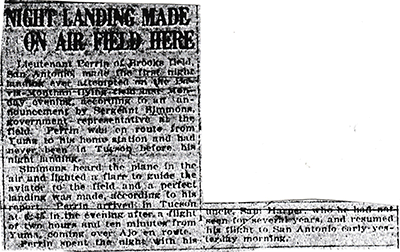 |
Regardless, back to his log book on PDF page 43. He and Fey remained at Tucson overnight, departing on the 20th for Yuma, AZ. His flight to Yuma was 2.5 hours. He left Lt. Fey at Yuma and returned on the same day solo to Tucson in another 2.5 hours. He remained in Tucson overnight again and departed for Marfa on the 21st. At Marfa he remained overnight and returned to Brooks Field in 3.5 hours on December 22nd.
Of real interest during this time period is an article that appeared in the Arizona Daily Star on December 23, 1925. The article is at left, but is very difficult to read. Therefore, because this is an important article, I've also included a boxed typescript of the article text, below.
Arizona Daily Star, December 23, 1925
Lieutenant Perrin of Brooks Field, San Antonio made the first night landing ever attempted on the Davis-Monthan flying field last Monday evening, according to an announcement by Sergeat Simmons [sic, the name should be Simpson], government representative at the field. Perrin was en routhe from Yuma to his home station and had never been in Tucson before his night landing.
Simmons [Dewey Simpson] heard the plane in the air and lighted a flare to guide the aviator to the field and a perfect landing was made, according to the report. Perrin arrived in Tucson at (unreadable) in the evening after a flight of two hours and ten minutes from Yuma, coming over Ajo en route.
Perrin spent the night with his uncle, Sam Harper, who he hasn't seen for several years and resumed his flight to San Antonio early yesterday morning. |
Thus we record the first night landing made at the field, with the help of a flare.
Continuing, of interest in this log book is the appearance of signatures of several fellow Register pilots. Wendell Brookley ( appears on PDF page 37 et al; he signed the Register 5/9/30; I need INFORMATION about Brookley. Please help if you can). Brookley served to certify Perrin's hours for October 1925. Earlier, Brookley placed second in the 1924 Pulitzer Race. He certified several other pages in Perrin's log. Likewise, on PDF page 42, appears Captain Barney Oldfield. He was a passenger with Perrin in a Curtiss JNS on December 11, 1925. Perrin ended flight log #3 on April 29, 1926 with 2,151:45 total flight hours.
---o0o---
Between logs three and seven, log books 4-6 must have recorded some of Perrin's flight activity in the Philippine Islands. We know he was there, because on May 7, 1929 he was listed with arriving citizens debarking from the ship S.S. U.S. Grant at San Francisco. The ship was inbound from Manila. He was traveling with his wife and son John Daniel, who was listed as 7 months old. Further, the 1930 U.S. Census places the three of them in Bexar, TX at 543 Barret [sic] Place, which Perrin rented for $35/month. For context, they lived on a block of ~$3,000 homes. He is identified as a lieutenant in the Air Service, U.S. Army. Bessie, age 33, was not employed outside the home.
---o0o---
LOG BOOK NUMBER SEVEN September 8, 1932 -April 27, 1934
During the time of this log, Perrin was based at Duncan Field, San Antonio, TX with the rank of Captain. From the first page of information in this log (PDF page 3), we learn that he was married to Bessie King Perrin (1896-1982). They had two sons, John Daniel and George. He was relatively tall at 5'11".
Elmer D. Perrin Pilot Log, Personal Information Page (Source: Webmaster)
 |
If you download this 58-page PDF (6.7Mb) at the link above, the first flights of interest appear on PDF page 5. The flights involved a grand cross-country trip from Randolph Field, TX to the west coast, up to Sacramento Mather Field. He passed through Tucson, but did not sign the Register. His return also passed through Tucson without a Register entry. He continued southeast to Shreveport, LA and return to Texas. Perrin flew a Fokker C-7A (probably 29-409). There was no indication of passenger numbers or names. This is an example of a Register pilot being in Tucson more times than indicated in the Register.
More important to us is that two of his landings cited in the Davis-Monthan Register are found on PDF page 35. There, flown in the Fokker C-7A, is a six-day trip logged from San Antonio, TX to San Diego, CA (Rockwell Field) and Los Angeles (March Field). He landed and signed the Tucson Register August 26, 1933 on the westbound leg. He signed again on August 29th during his eastbound flights. Please check Register page 200 to verify his signatures.
Elmer D. Perrin Pilot Log, Tucson Landings, August, 1933 (Source: Webmaster)
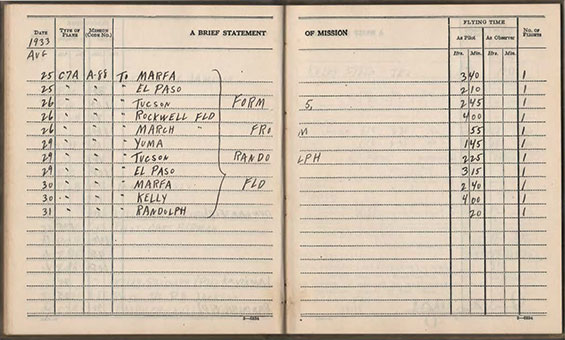 |
As with his log book #3, above, other Register pilots certified Perrin's flight hours from time to time. For example, Lester Maitland shows up on PDF page 7 ff. Maitland was the only officer to certify Perrin's flying throughout log book #7. L.N. Eller shows up on page 29 ff. I need information about Eller. If you can help, please let me KNOW. There is also a Captain J.A. Laird who shows up on PDF page 45 ff., dated November 29, 1933. There is a Laird who signed the Register, but did not enter a name or first initials. He was a military pilot based at San Antonio, so circumstantial evidence says he could be our Laird.
On PDF page 50, January 29, 1934, he endured a forced landing due to a problem with a fuel line. He went down near the east Texas town of Provident City, which is now a ghost town. Perrin ended his log book #7 on April 27, 1934 with 4,104:40 total flight hours. He had flown about 2,000 hours in the eight years since he closed log book #3. It's a pity we don't have his subsequent log books.
Elmer Perrin, Arlington Cemetery Grave Marker (Source: FG)
 |
Elmer D. Perrin Obituary, The New York Times, June 22, 1941 (Source: NYT)
 |
I could find no U.S. Census information for Perrin for the year 1940. However, according to the Army Directory for 1940, Perrin was assigned to the Air Corps procurement district, Baltimore, MD, so probably lived there. He was on assignment to the Martin aircraft plant, responsible for test flying and accepting new aircraft for the Army.
Perrin was killed June 21, 1941 near Baltimore while testing a B-26 Martin medium bomber ( #40-1386), which crashed and burst into flame. He is buried at the Arlington National Cemetery. He had earned the rank of Lieutenant Colonel and was promoted to full Colonel posthumously. His abbreviated obituary from The New York Times is at right. His grave marker from the Arlington National Cemetery is at left.
His interment record from Arlington is below.
Elmer D. Perrin, Arlington Interment Record, June 24 1941 (Source: ancestry.com)
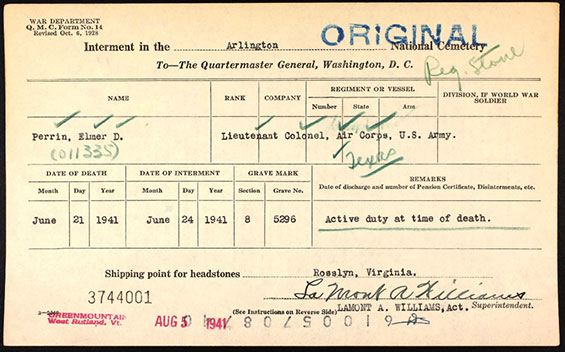 |
Another article from The New York Times of June 22, 1941 documented the crash near Baltimore, below left.
Elmer D. Perrin, Fatal Crash, The New York Times, June 22, 1941 (Source: NYT)
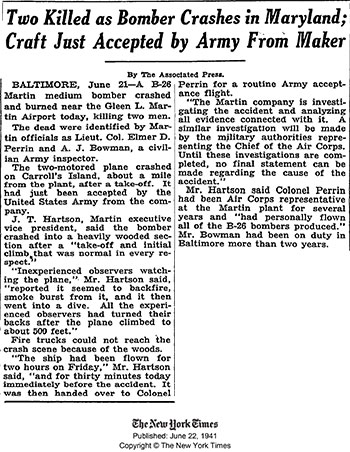 |
On February 23, 1942 Perrin Field, a.k.a. Perrin Air Force Base, near Sherman, TX, was officially dedicated to his memory. History and photos of Perrin and Perrin Field are at the link (please let me KNOW if you find the link is not functional). Perrin Field closed for good in the early 1970s. The site is now occupied by the North Texas Regional Airport with the identifier PNX cryptically memorializing and celebrating Perrin's name.
---o0o---
Dossier 2.2.199
THIS PAGE UPLOADED: 06/23/15 REVISED: 11/17/15, 08/24/16
|












